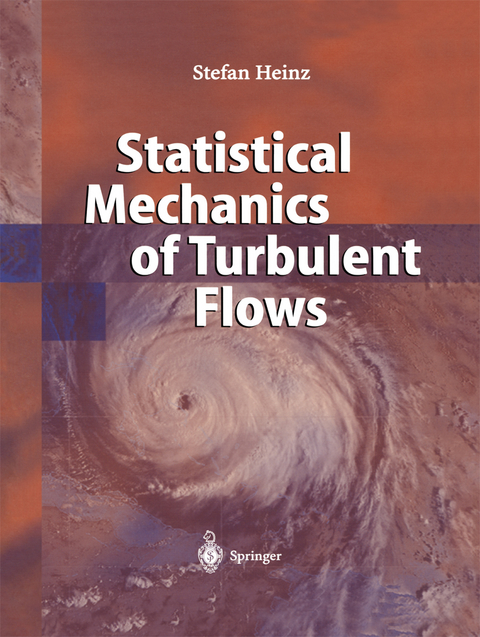
Statistical Mechanics of Turbulent Flows
Springer Berlin (Verlag)
978-3-642-07261-1 (ISBN)
The simulation of turbulent flows, connected with environmental protection and the design of chemical and engineering processes, is increasingly important and requires the assessment of complicated interactions, especially in reactive flows. This monograph systematically discusses which statistical methods are appropriate for computing turbulent flows, with special emphasis on environmental and geophysical flows. Applications to similar problems in physics and chemical and mechanical engineering are also described, as are some in nonlinear atmospheric chemistry. Statistical Mechanics of Turbulent Flows treats the underlying stochastic basics and applications, up through current developments in methods for calculating multi-phase flows. Readers learn how to construct a customized probability density function (PDF) for a given problem. The author, who has participated in the development of these efficient and effective methods, wrote this book for advanced students and practitioners.
Introduction: The basic equations; Turbulence models; Filter operations.- Stochastic variables: PDFs of one variable; The characterization of PDFs by moments; PDFs of several variables; Statistically most-likely PDFs; Examples for statistically most-likely PDFs; Examples for other PDFs; Theta and delta functions.- Stochastic processes: PDF transport equations; The Fokker-Planck equation; An exact solution to the Fokker-Planck equation; Stochastic equations for realizations; Stochastic modeling; The dynamics of relevant variables.- The equations of fluid and thermodynamics: The fluid dynamic variables; From the molecular to fluid dynamics; The closure of the fluid dynamic equations; The equations for multicomponent reacting systems; Direct numerical simulation; Reynolds-averaged Navier-Stokes equations; Second- and higher-order RANS equations.- Stochastic models for large-scale turbulence: A hierarchy of stochastic velocity models; The generalized Langevin model for velocities; A hierarchy of Langevin models; The Kolmogorov constant; A hierarchy of stochastic models for scalars; Compressible reacting flow: velocity models; Compressible reacting flow: scalar models; Stochastic models and basic equations; Consistent turbulence models; Nonlinear stochastic models.- Stochastic models for small-scale turbulence: The generalization of LES by FDF methods; The closure of the equation for filtered velocities; The closure of the scalar FDF transport equation; The closure of LES and FDF equations; The dynamic eddy length scale calculation; The scalar-conditioned convective flux; An assumed-shape FDF method.- The unification of turbulence models: The need for the unification of turbulence models; Unified turbulence models; Some unsolved questions. References.- Author index.- Subject index.
From the reviews:
"This book is a descriptive monograph with a focus on stochastic probability density function (pdf) procedures and their implementation for turbulent flow. ... The book includes a usefully extensive reference list, author and subject index. ... The book ... does provide a valuable survey of stochastic turbulent flow procedures supplementary to and in comparison with more conventional closure procedures. Considering the book's relatively modest price it would be a useful addition for personal as well as institutional acquisition." (AC Buckingham, Applied Mechanics Reviews, Vol. 57 (5), 2004)
"This is a nicely written textbook, aiming to present the methods of stochastic modelling of turbulent fluid flow. ... The author nicely and convincingly expands on the advantages of stochastic modelling ... . It deserves attention by the specialists and the beginners as well and has useful applications. It is clearly presented, with careful argumentation and interesting scientific contents. The book's use is nicely supported by an extended list of all symbols and abbreviations and, of course, with references. The reviewer can well recommend it." (Dr. S.Grossmann, European Journal of Mechanics B/Fluids, Issue 23, 2004)
"This is a handbook for a computational approach to reacting flows ... . This book offers a timely survey of techniques in modern computational fluid mechanics for turbulent flows with reacting scalars. It should be of interest to engineers, while the discussion of ... pdfs, stochastic and statistical equations should also be attractive to applied mathematicians and physicists. ... it is written clearly and concisely and should be useful to a large community, interested either in the underlying stochastic formalism or in CFD applications." (C Cambon, Journal of Physics A: Mathematical and General, Vol. 37 (40), 2004)
| Erscheint lt. Verlag | 30.11.2010 |
|---|---|
| Zusatzinfo | XXIV, 216 p. |
| Verlagsort | Berlin |
| Sprache | englisch |
| Maße | 210 x 279 mm |
| Gewicht | 366 g |
| Themenwelt | Naturwissenschaften ► Biologie ► Ökologie / Naturschutz |
| Naturwissenschaften ► Geowissenschaften ► Geophysik | |
| Naturwissenschaften ► Physik / Astronomie ► Astronomie / Astrophysik | |
| Naturwissenschaften ► Physik / Astronomie ► Theoretische Physik | |
| Schlagworte | atmospheric chemistry • chemical engineering • Combustion • environmental protection • fluid- and aerodynamics • Fluid Dynamics • fluid mechanics • Navier-Stokes Equation • ocean • Oceanography • Reynolds-averaged Navier-Stokes • scale • Simulation • Statistical Mechanics • Stochastic Processes • thermodynamics • Turbulence • Turbulent flow • Velocity Models |
| ISBN-10 | 3-642-07261-5 / 3642072615 |
| ISBN-13 | 978-3-642-07261-1 / 9783642072611 |
| Zustand | Neuware |
| Haben Sie eine Frage zum Produkt? |
aus dem Bereich


